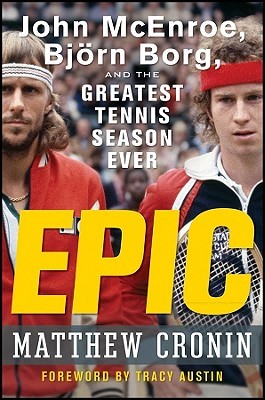New York Tennis Magazine’s Literary Corner: Epic: John McEnroe, Bjorn Borg and the Greatest Tennis Season Ever by Matthew Cronin

It is impossible not to compare Matthew Cronin’s Epic: John McEnroe, Bjorn Borg and the Greatest Tennis Season Ever with Stephen Tignor’s High Strung: Bjorn Borg, John McEnroe and the Untold Story of Tennis’ Fiercest Rivalry. If you have to read only one, I’d recommend Tignor’s book as he offers the reader more interesting period details about larger issues beyond the Borg-McEnroe matches. But Cronin’s book gives a compelling portrait of the famous matchup, and while it is a narrower take on the era, it has its share of stories that help put the rivalry between the two players in context.
Both books do a good job of setting their central drama, the Borg-McEnroe battles, against the background of an era when our sport was populated with a fascinating cast of players and functionaries, many of whom have had books written about their contribution to this rich era in tennis history. Cronin tells us a lot about players like Jimmy Connors, Vitus Gerulaitis, Ilie Nastase and Arthur Ashe on the men’s side and Chris Evert, Tracy Austin, Martina Navratilova and Evonne Goologong among the women.
Epic features a foreword from Tracy Austin, herself the author of a memoir that has achieved a kind of mini-fame by being attacked by the tennis enthusiast and author David Foster Wallace.
One of the most interesting tidbits that Cronin provides, although it is pretty far removed from the Borg-McEnroe central theme, is the story of Chris Evert being barred from visiting her then fiancée, Jimmy Connors, the night before his 1974 U.S. Open finals match with Ken Rosewood. Apparently, Connors coach, Pancho Segura, forbade any distractions and Evert left in tears.
Another highlight of Cronin’s book is his interview with Long Island tennis pro Gene Mayer who describes what playing Borg at Wimbledon was like: "At Wimbledon, there was never the sense that he (Borg) wasn’t beatable, he was constantly struggling and down." It is interesting that his fellow competitors thought Borg was beatable on grass, despite his run of five Wimbledon titles. It’s as if his six French titles were more intimidating as Mayer goes on to say that nobody thought they had a chance against Borg on clay.
It is understandably tempting for Cronin to supply the reader with some period background to "set" the Borg-McEnroe face-off in the context of other things going on in the late 1970s and early 1980s. But this impulse is particularly troubling as it leads him into tangents about how the Italian "Red Brigades" terrorism affected the Italian Open or the effect of India’s nuclear bomb tests on the lead-up to Roland Garros.
It is the rare tennis writer who is content to just write about tennis, whether it’s Pete Bodo’s treatment of the murdered Iraqi tennis player some years ago, or Mitchell Jon Fisher’s book about the 1938 match between the U.S. and German Davis Cup teams.
The impulse to muck around with themes larger than tennis gets Cronin in trouble as his uses McEnroe’s high media profile to align him with just about everybody except Mother Theresa. "Like McEnroe, Reagan was no fan of compromise or being proverbially held hostage by another person’s rules or regulations." This sentence comes in the midst of an eight-paragraph run in which the author compares the U.S. President to the tennis star from Queens.
But apparently, the McEnroe personality is elastic, as Cronin sees it, because he also writes that "Mac wasn’t quite a rebel without a cause like his folk hero, James Dean."
Then, Cronin quotes McEnroe’s doubles partner, Peter Fleming, as saying, "Sitting in the stands, the guys who were the punk rockers were for Junior (McEnroe). He was the Sex Pistols of tennis."
Just to prove that you can compare McEnroe to anybody, Cronin quotes tennis writer Pete Bodo as saying that John was like billionaire recluse Harold Hughes. For my part, I think McEnroe’s artistry on the court resembled Liberace and Jay-Z. Well, you get the idea.
Other scene-setting mistakes Cronin throws in lead him to write a paragraph that begins: "France has been known for some time to be a liberal, permissive nation" and that goes on to mention Charles Manson and Roman Polanski in order to set the scene for the 1978 French Open, which Borg won without dropping a set.
But Cronin does well to pay attention to McEnroe’s doubles career by including a lot of material gleaned from interviews with his partner, Peter Fleming. In one unintentionally funny comment, along the lines of the "I’m not robbing and stealing" phrase so common here in New York, Fleming says of his career with McEnroe, "We would never tank just because one of us got beat." Well, that’s a relief.
I didn’t come across any errors of the magnitude of Tignor’s saying that Gerulaitis was from Brooklyn, so it is safe to conclude that Epic is more carefully edited than High Strung. Now that we have had two books on the Borg-McEnroe rivalry, two books on the Nadal-Federer 2008 Wimbledon match, I guess we will soon see a few takes on Djokovic’s record-setting 2011. You have to appreciate tennis writers who stake out their own path like Long Island Tennis Magazine’s Mark "Scoop" Malinowski. You’re not going to see dueling bios of the unpopular former number one Marcello Rios any time soon.






